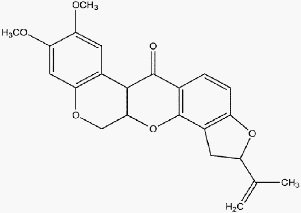What is Rotenone?
 Rotenone is a naturally-occurring compound derived from the roots of tropical plants in the genus Derris, Lonchocarpus or Tephrosia. It has been used for centuries by natives in Central and South America to catch fish for food. Rotenone has been used as a pesticide since the mid 1800s and by fish managers in the U.S. since the 1930s to remove unwanted or invasive fish. Rotenone is an active ingredient in many insecticides and in the United States past uses have included it use in gardens, commercially-raised crops, stored grain and for treating lice on domestic animals such as dogs and horses.
Rotenone is a naturally-occurring compound derived from the roots of tropical plants in the genus Derris, Lonchocarpus or Tephrosia. It has been used for centuries by natives in Central and South America to catch fish for food. Rotenone has been used as a pesticide since the mid 1800s and by fish managers in the U.S. since the 1930s to remove unwanted or invasive fish. Rotenone is an active ingredient in many insecticides and in the United States past uses have included it use in gardens, commercially-raised crops, stored grain and for treating lice on domestic animals such as dogs and horses.
Currently, rotenone is commercially available as either a wettable-powder or liquid and is registered by the Environmental Protection Agency (EPA) as a restricted-use pesticide for fish management. Readily absorbed through the gills, rotenone is lethal to fish because it blocks the biochemical process that allows fish to utilize the oxygen in their blood during cellular respiration. Draining and chemical treatment are usually the only practical way to completely eradicate invasive fish. In most cases, chemical treatment is a far more efficient and practical method than draining. It can also be neutralized with potassium permanganate.
